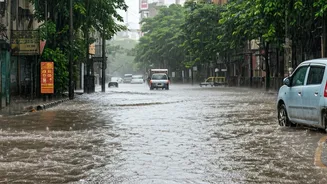Rainfall's Fury Unleashed
Mumbai was recently battered by torrential rainfall, a significant weather event that affected several regions within the city. The intensity of the downpour
was substantial, with numerous areas recording rainfall exceeding 50 mm. The heavy rain presented a considerable challenge, causing disruption and highlighting the city's preparedness for such extreme conditions. This significant amount of rain in a short period brought the focus on the city's existing infrastructure and its capability to manage such a deluge. The impact of the rainfall was felt across various sectors, which further underscores the need for proactive measures to counter the effects of such weather events. This instance served as a crucial reminder of the importance of constant monitoring and proactive planning, so Mumbai can remain resilient and cope effectively with future weather adversities.
Impacts on Daily Life
The heavy rainfall in Mumbai had several repercussions on the daily lives of its citizens. The downpour resulted in the disruption of traffic flow across various key routes, thereby significantly increasing commute times for many residents. Public transportation was also affected, which caused further inconvenience. Schools and educational institutions faced difficulties and adjusted operations according to the prevailing weather conditions. Waterlogging in low-lying areas added to the challenges, making it difficult for people to navigate the streets. In some parts of the city, the rainfall also led to power outages and communication disruptions, making it difficult for people to continue their daily routines. The intense weather highlighted the necessity of improved infrastructure and immediate responses to mitigate the effects of extreme weather events.
Emergency Responses and Relief
Following the heavy rain, emergency services and local authorities sprang into action to offer relief and support. The focus of the initial response was on ensuring the safety of residents and providing essential assistance in the affected areas. Teams were deployed to address the problems of waterlogging, remove debris, and repair infrastructure damage, where possible. Special attention was paid to the most vulnerable communities to guarantee they received the necessary support. The disaster management teams worked tirelessly, coordinating with various departments and agencies to bring the situation under control. Efforts were also made to restore power supply and communication services, which were disrupted by the rainfall. Public awareness campaigns were launched to inform citizens about the safety measures and to guide them on how to respond to the situation, which enhanced the effectiveness of the relief operations.
Long-Term Preparedness Plans
The recent heavy rainfall in Mumbai underscored the need for long-term strategies and enhancements to improve the city's resilience. There is a need to upgrade drainage systems, so they can effectively handle the increased rainfall volume. City planners and engineers are reviewing infrastructure to identify and address weaknesses, preventing future waterlogging and damage. Emphasis has also been placed on creating effective early warning systems to alert people of potential dangers. In addition to physical infrastructure, authorities are also investing in community outreach programs to educate residents about preparedness measures and safety protocols during extreme weather. These initiatives aim to reduce the impact of rainfall and improve the city's capacity to withstand future weather events, which ensure continuous improvement and adaptation.















